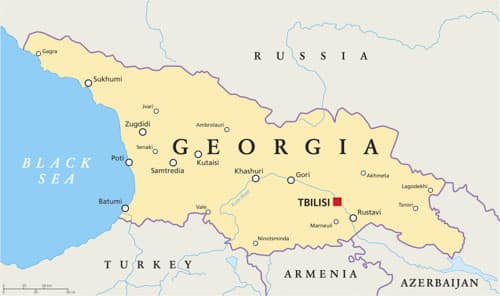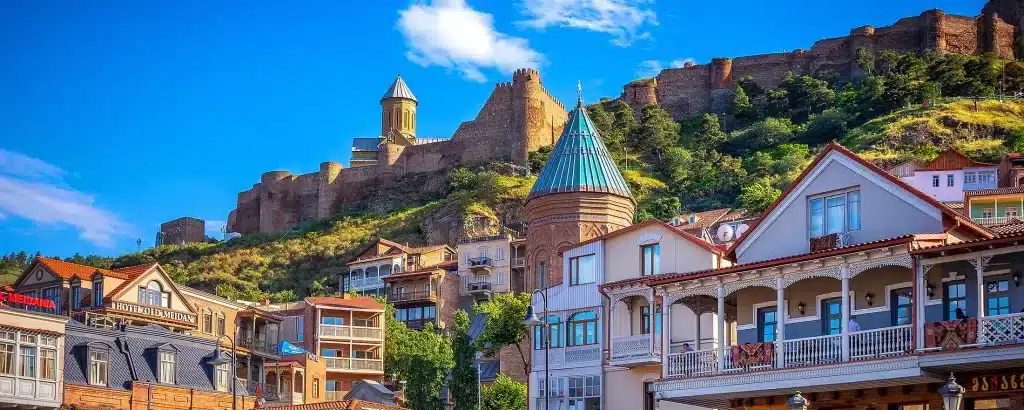3 Fascinating Facts about the Georgian Language
The Georgian language is the official language of the Republic of Georgia and is composed of several dialects. The Georgian ..

The Georgian language is the official language of the Republic of Georgia and is composed of several dialects. The Georgian language is divided into Eastern Georgian and Western Georgian groups, which are spoken alongside the Mingrelian (Megrelian) and Laz (Chan) languages and the Kartvelian languages in the South Caucasus region. Additionally, Georgian is spoken in parts of Azerbaijan, northeastern Turkey, and several villages in the Isfahan region of Iran. In this article, we delve into the history of the Georgian language from its origins to the present day. Follow along with us.
Overview of Georgia
Georgia is one of the most important countries located in the Caucasus region of southeastern Europe. It is bordered by Russia to the north, Turkey and Armenia to the south, Azerbaijan to the east, and the Black Sea to the west. Georgia has a rich and diverse history, with the Ancient Georgian Kingdom being one of the oldest cultures in the region. Georgia has been influenced by numerous civilizations and empires throughout the ages, including the Greeks, Romans, Arabs, Mongols, and Ottomans. Georgia also boasts stunning natural landscapes and a rich cultural heritage, making it a unique tourist destination. Moreover, it is among the top countries targeted by students for studying abroad, as it houses important international and accredited universities.

The weather in Georgia is distinct and differs from any other place, as it combines all four seasons simultaneously, earning it the nickname “Land of the Four Seasons.” The Georgian Orthodox religion is the main creed in the country. Georgia possesses numerous tourist attractions, most of which are located in the capital city of Tbilisi, known for its historic old town, the Bridge of Peace, and the Metekhi Church. Georgia also encompasses breathtaking natural areas such as the Caucasus Mountains, Black Sea resorts, the Kazbegi Valley, and various natural parks and reserves. The Georgian language is the official language in Georgia and is one of the oldest languages in the world, which is the topic of our article today.
History of the Georgian Language
The Georgian language belongs to the Caucasian language family and is the official language of the country of Georgia, spoken by nearly four million people as a first or second language. It is a group of languages that have been spoken in the Caucasus Mountains region for thousands of years. There are three linguistic groups within the Caucasian languages: Abkhaz-Adyghean (Northwest Caucasus), Nakh-Daghestanian (Northeast Caucasus), and Kartvelian (South Caucasus). The Georgian language, alongside the Mingrelian, Laz, and Svan languages, belongs to the Kartvelian language family. The other Kartvelian languages, Mingrelian, Svan, and Laz, are primarily spoken in western Georgia, and the Laz community in Turkey also speaks Laz.
The earliest references to the Georgian language were found in the writings of Marcus Cornelius Fronto, a Roman rhetorician from the 2nd century AD. The earliest evidence of the language comes from inscriptions dating back to the 5th century. The oldest literary work is believed to be the epic poem “The Knight in the Panther’s Skin,” written by Shota Rustaveli in the 12th century. The formation of the Georgian script is attributed to King Parnavaz, a ruler of Iberia in the 3rd century BC. However, the oldest existing printing of the Georgian alphabet, discovered on a slab in Palestine, dates back to 430 AD and is written in the Asomtavruli script.
Translation: Georgian literary tradition dates back to the 5th century in the form of inscriptions. Many literary works from the ancient Georgian era (5th and 11th centuries) still exist, including translations of the Bible. Modern Georgian literary language is based on the Eastern Georgian dialect and emerged in secular literature in the 12th century. It was fully established in the mid-19th century, and Georgian was used for religious purposes until the beginning of the 19th century.

Stages of the Georgian language:
- Early Old Georgian: 5th and 8th centuries.
- Old Classical Georgian: 9th and 11th centuries.
- Middle Georgian: 11th/12th to 17th/18th centuries.
- Modern Georgian: 17th and 18th centuries to the present.
Information about the Georgian language:
- The Georgian alphabet has three writing systems.
- Georgian is a pro-drop language (omitting pronouns).
- Most Georgian surnames have endings like -dze (“son”) or -shvili (“child”).
- The Georgian language belongs to the Kartvelian language family, which includes Svan, Zan, and Laz.
- Georgian has 18 dialects that retain unique morphological, syntactic, lexical, and phonetic features.
- Georgian is an agglutinative language (new words are formed by adding prefixes and suffixes together).
- Georgian has seven nominal cases (nominative, accusative, dative, genitive, ergative, instrumental, vocative).

- Georgian has a flexible word order, often using a subject-verb-object order, but sometimes varying the order of verb and subject.
- Georgian has multiple initial consonant clusters, with up to six consecutive consonants appearing at the beginning of words.
- Georgian uses a vigesimal numeral system (e.g., “93” is translated literally as “four times twenty plus thirteen”).
Due to unique dialects and terms in each region, it is somewhat easy to discern which part of Georgia a person belongs to. - Modern Georgian alphabet consists of 33 letters, including 5 vowels and 28 consonants, written and read from left to right, without capital letters.
- Due to its unique vocabulary and complex structure, Georgian is often considered a highly challenging language to learn. However, understanding its basic structure can be beneficial for anyone interested in learning Georgian.
Three fascinating facts about the Georgian language:
- Georgian does not use definite or indefinite articles (like “the” or “a” in English) at all, similar to Chinese, Japanese, Estonian, and Finnish. Instead, the information typically conveyed by articles is conveyed through word order. However, Georgian has a flexible word order, often using a subject-verb-object order, but sometimes varying the order of verb and subject.
- Georgian has three ways to express negation. When negating in Georgian, speakers must choose between “ar” (no), “ver” (cannot), and “nu” (no!). While “ar” is commonly used (e.g., Tsasvla ar Minda; I don’t want to go), “ver” indicates the inability to perform an action (e.g., Ver movei; I couldn’t come), and “nu” is only used for negative commands (e.g., Nu nerviulob!; Don’t worry!).
- Georgian has two sets of month names based on the ancient Georgian calendar, reflecting traditional agricultural seasons. Old month names include Ap’nisi (Month of Water) for January, Tibatve (Month of Sowing) for June, and Mk’atatve (Month of Harvest) for July. In the old calendar, the new year started in September. Modern month names mimic the Gregorian calendar, such as Dek’emberi for December.
In conclusion, as you can see, the Georgian language is linguistically and culturally rich, being one of the oldest languages in the world. If you are planning to travel to Georgia, don’t worry about the language, as most Georgians speak English. However, of course, you will have a unique experience if you learn this ancient language. Now, if you have any questions about traveling and life in Georgia, you can reach out to us, and we are always happy to provide you with all the information that helps you make a decision about visiting this wonderful country.
Source: Discovering Languages: 10 Things You (Maybe) Didn’t Know About the Georgian Language
